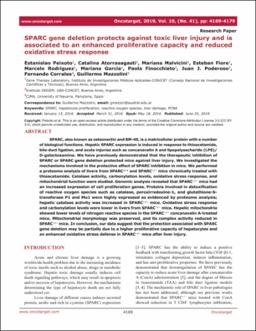| dc.description.abstract | SPARC, also known as osteonectin and BM-40, is a matricellular protein with a number of biological functions. Hepatic SPARC expression is induced in response to thioacetamide, bile-duct ligation, and acute injuries such as concanavalin A and lipopolysacharide (LPS)/D-galactosamine. We have previously demonstrated that the therapeutic inhibition of SPARC or SPARC gene deletion protected mice against liver injury. We investigated the mechanisms involved in the protective effect of SPARC inhibition in mice. We performed a proteome analysis of livers from SPARC+/+ and SPARC−/− mice chronically treated with thioacetamide. Catalase activity, carbonylation levels, oxidative stress response, and mitochondrial function were studied. Genomic analysis revealed that SPARC−/− mice had an increased expression of cell proliferation genes. Proteins involved in detoxification of reactive oxygen species such as catalase, peroxirredoxine-1, and glutathione-S-transferase P1 and Mu1 were highly expressed as evidenced by proteome analysis; hepatic catalase activity was increased in SPARC−/− mice. Oxidative stress response and carbonylation levels were lower in livers from SPARC−/− mice. Hepatic mitochondria showed lower levels of nitrogen reactive species in the SPARC−/− concanavalin A-treated mice. Mitochondrial morphology was preserved, and its complex activity reduced in SPARC−/− mice. In conclusion, our data suggest that the protection associated with SPARC gene deletion may be partially due to a higher proliferative capacity of hepatocytes and an enhanced oxidative stress defense in SPARC−/− mice after liver injury. | en_US |


